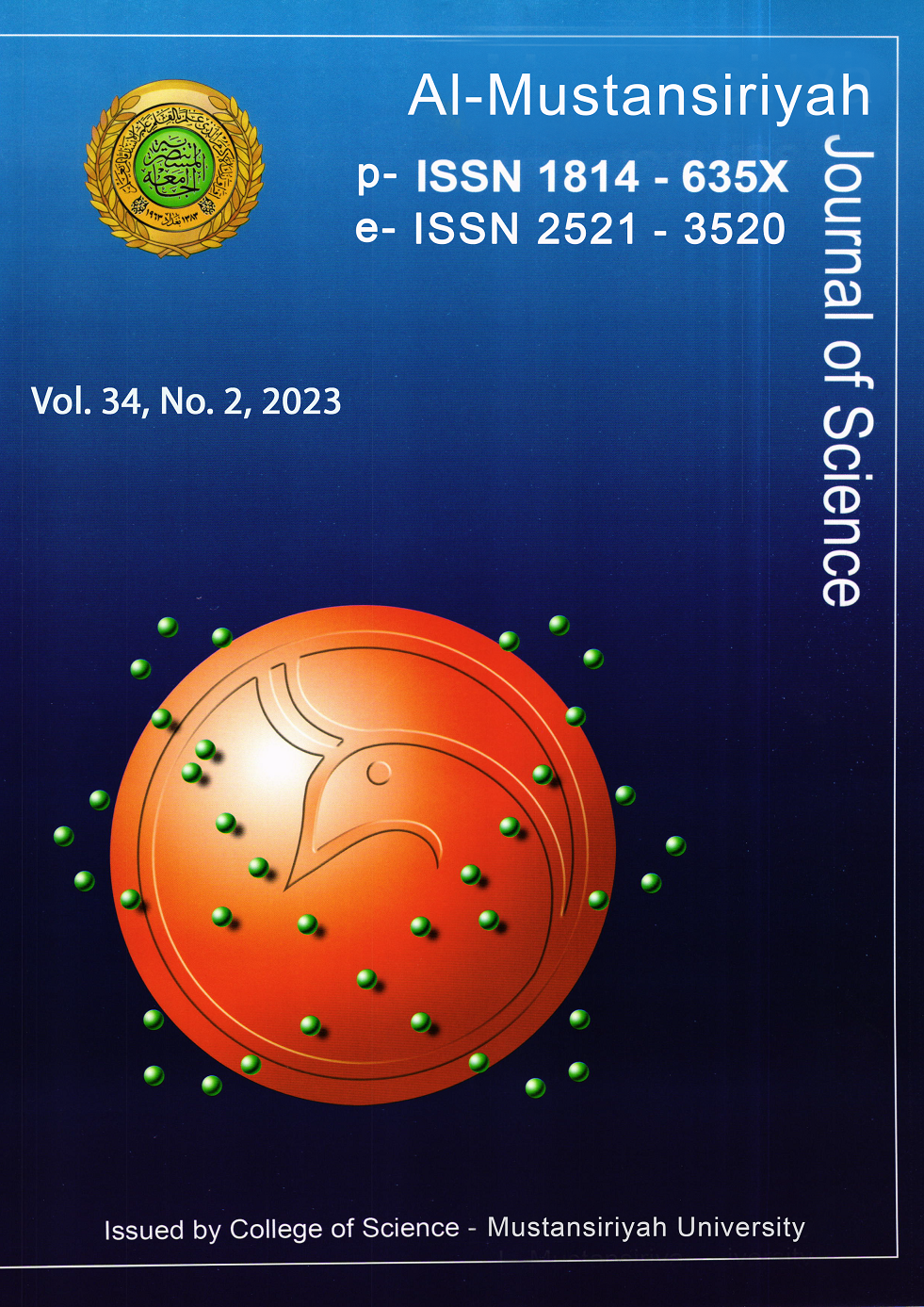Activated Carbon Nanoparticles as Adsorbent to Remove the Cadmium Ion from Aqueous Solution: Thermodynamic Study
DOI:
https://doi.org/10.23851/mjs.v34i2.1260Keywords:
Activated carbon nanoparticles, barley, Cadmium pollution, Bio-adsorbentsAbstract
Human activities such as fossil fuel burning, car exhaust, mining, agriculture, and the incineration of solid and liquid wastes all contribute to water pollution by heavy metals, therefore this water poisoning poses a threat to living beings. To minimize the pollution of the natural waters, As the adsorption process of metal in solutions, it is critical to identify effective strategies for getting rid of these toxins. This study involves the characterization and synthesis of novel activated carbon nanoparticles (AC) from natural sources (barley) and is applied in an adsorption study to remove cadmium metal. (AC) characterization using XRD, SEM and it was nanoscale in size and particle-like in shape also BET for specific surface area nitrogen adsorption isotherm nitrogen) 718.01 ) and Average pore diameter as (16.851(Å)), from the adsorption experimental data, the results are best described by the Freundlich isotherm model, which has an adsorption removal 76.86% with exothermic process.
Received: 06/12/2022
Revised: 27/01/2023
Accepted: 31/01/2023
Downloads
References
N. Sharma, K. K. Sodhi, and M. Kumar, "Heavy metal pollution: Insights into chromium eco-toxicity and recent advancement in its remediation," Environ. Nanotechnology, Monit. Manag., vol. 15, p. 100388, 2021.
M. L. Sall, A. K. D. Diaw, and D. Gningue-Sall, "Toxic heavy metals: impact on the environment and human health, and treatment with conducting organic polymers, a review," Environ. Sci. Pollut. Res., vol. 27, no. 24, pp. 29927-29942, 2020.
S. Saini and G. Dhania, Cadmium as an Environmental Pollutant: Ecotoxicological Effects, Health Hazards, and Bioremediation Approaches for Its Detoxification from Contaminated Sites. 2020.
Y. C. Sharma, "Thermodynamics of removal of cadmium by adsorption on an indigenous clay," Chem. Eng. J., vol. 145, no. 1, pp. 64-68, 2008.
G. Genchi, M. S. Sinicropi, and G. Lauria, "The effects of cadmium toxicity," Int. J. Environ. Res. Public Health, vol. 17, no. 11, pp. 1-24, 2020.
A. Maleki, A. H. Mahvi, and M. A. Zazouli, "Aqueous cadmium removal by adsorption on barley hull and barley hull ash," Asian J. Chem., vol. 23, no. 3, pp. 1373-1376, 2011.
A. Maleki, R. Rezaee, and R. Ebrahimi, "Fluoride adsorption from aqueous systems using barley husk and barley husk ash," in Proceedings of the 30th Conference of the. International Society for Fluoride Research, which will be held, 2012, pp. 5-8.
N. A. A. Aboud, B. E. Jasim, and A. M. Rheima, "Methylene orange dye removal in aqueous solution using synthesized cdo-mno2 nanocomposite: Kinetic and thermodynamic studies," Chalcogenide Lett., vol. 18, no. 5, pp. 237-243, 2021.
N. A. A. Aboud, B. E. Jasim, and A. M. Rheima, "Adsorption study of phosphate ions pollution in aqueous solutions using microwave synthesized magnesium oxide nanoparticles," vol. 16, no. 3, pp. 801-807, 2021.
M. A. Hadj Ammar, B. Benhaoua, and K. Salhi, "Performance Study and Advantages of a Novel Activated Carbon Adsorption Cycle Run by Sunlight," Arab. J. Sci. Eng., vol. 46, no. 6, pp. 5933-5944, 2021.
T. C. Egbosiuba, A. S. Abdulkareem, and A. S. Kovo, "Ultrasonic enhanced adsorption of methylene blue onto the optimized surface area of activated carbon: Adsorption isotherm, kinetics and thermodynamics," Chem. Eng. Res. Des., vol. 153, pp. 315-336, 2020.
P. M. Sanka, M. J. Rwiza, and K. M. Mtei, "Removal of Selected Heavy Metal Ions from Industrial Wastewater Using Rice and Corn Husk Biochar," Water. Air. Soil Pollut., vol. 231, no. 5, 2020.
P. Kalyani and A. Anitha, "Refuse derived energy - tea derived boric acid activated carbon as an electrode material for electrochemical capacitors," Port. Electrochim. Acta, vol. 31, no. 3, pp. 165-174, 2013.
Q. Jiang, M. Z. Qu, and G. M. Zhou, "A study of activated carbon nanotubes as electrochemical super capacitors electrode materials," Mater. Lett., vol. 57, no. 4, pp. 988-991, 2002.
D. Propolsky, E. Romanovskaia, W. Kwapinski, and V. Romanovski, "Modified activated carbon for deironing of underground water," Environ. Res., vol. 182, p. 108996, 2020.
M. Kwiatkowski, J. Serafin, A. M. Booth, and B. Michalkiewicz, "Computer analysis of the effect of activation temperature on the microporous structure development of activated carbon derived from common polypody," Materials (Basel)., vol. 14, no. 11, 2021.
D. Ngakan, K. Putra, T. Gde, T. Nindhia, and I. W. Surata, "ScienceDirect Textural characteristics of activated carbons derived from tabah bamboo manufactured by using H 3 PO 4 chemical activation," Mater. Today Proc., vol. 22, pp. 148-155, 2020.
M. Hasanzadeh, A. Simchi, and H. Shahriyari Far, "Nanoporous composites of activated carbon-metal organic frameworks for organic dye adsorption: Synthesis, adsorption mechanism and kinetics studies," J. Ind. Eng. Chem., vol. 81, pp. 405-414, 2020.
E. C. Lima, A. A. Gomes, and H. N. Tran, "Comparison of the nonlinear and linear forms of the van't Hoff equation for calculation of adsorption thermodynamic parameters (∆S° and ∆H°)," J. Mol. Liq., vol. 311, p. 113315, 2020.
Downloads
Key Dates
Published
Issue
Section
License
Copyright (c) 2023 Al-Mustansiriyah Journal of Science

This work is licensed under a Creative Commons Attribution-NonCommercial 4.0 International License.
(Starting May 5, 2024) Authors retain copyright and grant the journal right of first publication with the work simultaneously licensed under a Creative Commons Attribution (CC-BY) 4.0 License that allows others to share the work with an acknowledgement of the work’s authorship and initial publication in this journal.






















